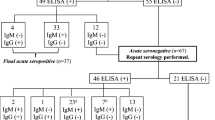Abstract
In 1986, a 26% seroprevalence of IgG- anti-Borrelia burgdorferi antibodies was observed among 950 orienteers and the incidence of new clinical infections was 0.8%. In 1993, a total of 305 seropositive orienteers were reexamined. During that time, 15 cases (4.9%) of definite/probable Lyme disease occurred in this seropositive group (12 skin manifestations and 3 monoarticular joint manifestations). Among the 12 definite cases, 9 showed new clinical infections (7 EM, 1 acrodermatitis chronica atrophicans, 1 arthritis), and 3 were recurrent (2 EM, 1 arthritis). The annual incidence (0.8%) in this seropositive group was identical to the incidence observed among the whole population in 1986. The individual antibody titer decreased slightly but the seroreversion rate was low (7%). Serology was not very helpful in identifying clinical cases and evolutions, and it can be stated, that a positive serology is much more frequent in this risk group than clinical disease.
Similar content being viewed by others
References
Steere AC, Malawista SE, Snydman DR, et al. Lyme arthritis: An epidemic of oligoarticular arthritis in children and adults in three Connecticut communities. Arthritis Rheum 1977; 20: 7–11.
Steere AC. Medical progress: Lyme disease. New Eng J Med 1989; 321: 586–596.
Gern L, Burgdorfer W, Aeschlimann A, et al. The ecology of Lyme borreliosis in Europe. In: Weber K, Burgdorfer W (eds), Aspects of Lyme borreliosis. Berlin, Heidelberg: Springer Verlag, 1992: 59–69.
Aeschlimann A. Ixodes ricinus L., essai pré liminaire de synthèse sur la biologie de cette espèce en Suisse. Acta Trop 1972; 29: 321–340.
Gern L, de Marval F, Aeschlimann A. Comparative considerations on the epidemiology of Lyme borreliosis and tick-borne encephalitis in Switzerland. In: Modern Acarology. Vol. 1. Prague: Academia and The Hague: Academic Publishing, 1991: 249–255.
Guy E, Martyn CN, Bateman DE, et al. Lyme disease: Prevalence and clinical importance of Borrelia burgdorferi specific IgG in forestry workers. Lancet 1989; 484–485.
Goldstein MD, Schwartz BS, Friedmann C, Maccarillo B, et al. Lyme disease in New Jersey outdoor workers: A statewide survey of seroprevalence and tick exposure. Am J Publ Health 1990; 10: 1225–1229.
Blaauw I, Nohlmans L, van den Berg-Loonen E, Rasker J, et al. Lyme arthritis in the Netherlands: A nation wide survey among rheumatologists. J Rheumatol 1991; 18: 1819–1822.
Fahrer H, van der Linden SM, Sauvain MJ, Gern L, et al. The prevalence and incidence of clinical and asymptomatic Lyme borreliosis in a population at risk. J Infect Dis 1991; 163: 305–310.
Zhioua E. Enquête séro-épidémiologique de la borré-liose de Lyme chez une population suisse à risque (coureurs d'orientation) [Dissertation]. Neuchâtel, Switzerland: University of Neuchâtel, 1993, 153pp.
Steere AC, Taylor E, Wilson ML, Levine SF, et al. Longitudinal assessment of the clinical and epidemiological features of Lyme disease in a defined population. J Infect Dis 1986; 54: 295–300.
Hanrahan JP, Benach JL, Coleman JL, et al. Incidence and cumulative frequency of endemic Lyme disease in a community. J Infect Dis 1984; 150: 489–496.
Russell H, Simpson JS, Schmid GP, Wilkinson HW, et al. Enzyme-linked immunosorbent assay and immunofluorescence for Lyme disease. J Infect. Dis 1984; 149: 465–470.
Nadal D, Wunderli W, Briner H, Hansen K. Prevalence of antibodies to Borrelia burgdorferi in forestry workers and blood donors from the same region in Switzerland. Eur J Clin Microbiol Infect Dis 1989; 8: 992–995.
Schmidt R, Ackermann R, Kabatzki J, Hartund H. Epidemiological aspects of Erythema Chronicum Migrans disease in the Federal Republic of Germany. Zentralbl Mikrobiol 1986; A 263: 412–419.
Muenchhoff P, Wilske B, Preac-Mursic V, Schierz G. Antibodies against Borrelia burgdorferi in Bavarian forest workers. Zentralbl Mikrobiol 1986; A 263: 412–419.
Schwartz BS, Goldstein MD, Childs JE. Longitudinal study of Borrelia burgdorferi infection in New-Jersey outdoor workers, 1988–1991. Am J Epidemiol 1994; 139: 504–512.
Gustafson R, Forsgren M, Gardulf A, Granström M, et al. Antibody prevalence and clinical manifestations of Lyme borreliosis and tick-borne encephalitis in Swedish orienteers. Scand J Infect Dis 1993; 25: 605–611.
Berglund J, Hansen BU, Eitrem R. Lyme arthritis – a common manifestation in a highly endemic area in Sweden. J Rheumatol 1995; 22: 695–701.
Gustafson R, Svenungsson B, Forsgren M, Gardulf A, et al. Two-year survey of the incidence of Lyme borreliosis and tick-borne encephalitis in a high risk population in Sweden. Eur J Clin Microbiol Infect Dis 1992; 10: 894–900.
Hu CM, Leuba-Garcia S, Aeschlimann A, Kramer MD, et al. Comparison in the immunochemical properties of Borrelia burgdorferi isolates from Ixodes ricinus derived from three endemic areas in Switzerland. Epidem Infect 1994; 112: 533–542.
Author information
Authors and Affiliations
Rights and permissions
About this article
Cite this article
Fahrer, H., Sauvain, M., Zhioua, E. et al. Longterm survey (7 years) in a population at risk for Lyme borreliosis: What happens to the seropositive individuals?. Eur J Epidemiol 14, 117–123 (1998). https://doi.org/10.1023/A:1007404620701
Issue Date:
DOI: https://doi.org/10.1023/A:1007404620701




